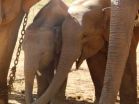(Press-News.org) PITTSBURGH, Feb. 4, 2013 – University of Pittsburgh Cancer Institute (UPCI) researchers have uncovered a technique to halt the growth of cancer cells, a discovery that led them to a potential new anti-cancer therapy.
When deprived of a key protein, some cancer cells are unable to properly divide, a finding described in the cover story of the February issue of the Journal of Cell Science. This research is supported in part by a grant from the National Institutes of Health.
"This is the first time anyone has explained how altering this protein at a key stage in cell reproduction can stop cancer growth," said Bennett Van Houten, Ph.D., the Richard M. Cyert Professor of Molecular Pharmacology at UPCI and senior author of the research paper. "Our hope is that this discovery will spur the development of a new type of cancer drug that targets this process and could work synergistically with existing drugs."
All cells have a network of mitochondria, which are tiny structures inside cells that are essential for energy production and metabolism. Dynamin-related protein 1 (Drp1) helps mitochondria undergo fission, a process by which they split themselves into two new mitochondria.
In breast or lung cancer cells made to be deficient in Drp1, the researchers observed a huge network of highly fused mitochondria. These cancer cells appear to have stalled during a stage in cell division called G2/M. Unable to divide into new cells, the cancer growth stops. Those cells that do try to divide literally tear their chromosomes apart, causing more stress for the cell.
The cover of the Journal of Cell Science includes a colorful image of a breast cancer cell deficient in Drp1 that is stuck during the process of separating its chromosomes into two identical sets to be divided among two new cells. Lead author Wei Qian, Ph.D., a postdoctoral fellow in Dr. Van Houten's laboratory, captured the image using a confocal microscope at Pitt's Center for Biologic Imaging run by Simon Watkins, Ph.D., a co-author of this study.
"Once we revealed this process for halting cancer cell growth by knocking out Drp1, we began looking into existing compounds that might utilize a similar mechanism," said Dr. Van Houten. "Now that we know affecting mitochondria in this manner inhibits cell growth, we could target drugs to this biological process to treat cancer."
The researchers found a compound called Mdivi-1 that makes cancer cells behave much the way they do when deficient in Drp-1. When used in combination with cisplatin, a drug already used to treat many solid cancers, rapid cell death can be induced in a wide range of cancer cells. This means that Mdivi-1 makes cisplatin work better.
Mdivi-1 is being tested in cancer cells in a laboratory setting. Those tests show that, while the compound acts as though it is depriving cancer cells of Drp1, it is actually using a different mechanism.
"To me, that's the serendipity of science, and it's really exciting," said Dr. Van Houten, who hopes eventually to move his laboratory tests on Mdivi-1 to clinical trials. "We were on the hunt for a drug that could make cancer cells deficient in Drp1 and, instead, we found a new cancer therapy that seems to work really well."
###Additional co-authors include Serah Choi, Gregory A. Gibson, and Christopher J. Bakkenist, Ph.D., all of the University of Pittsburgh.
This work was funded in part by a grant with the Pennsylvania Department of Health, PA CURE. It also was supported by funding from NIH grants R01CA148644, P30CA047904, P50CA097190, and P50CA121973.
About UPCI
As the only NCI-designated comprehensive cancer center in western Pennsylvania, UPCI is a recognized leader in providing innovative cancer prevention, detection, diagnosis, and treatment; bio-medical research; compassionate patient care and support; and community-based outreach services. UPCI, a partner with UPMC CancerCenter, investigators are world-renowned for their work in clinical and basic cancer research.
http://www.upmc.com/media
Pitt researchers reveal mechanism to halt cancer cell growth, discover potential therapy
2013-02-04
ELSE PRESS RELEASES FROM THIS DATE:
Men are from Mars Earth, women are from Venus Earth
2013-02-04
For decades, popular writers have entertained readers with the premise that men and women are so psychologically dissimilar they could hail from entirely different planets. But a new study shows that it's time for the Mars/Venus theories about the sexes to come back to Earth.
From empathy and sexuality to science inclination and extroversion, statistical analysis of 122 different characteristics involving 13,301 individuals shows that men and women, by and large, do not fall into different groups. In other words, no matter how strange and inscrutable your partner may ...
Low rainfall and extreme temperatures double risk of baby elephant deaths
2013-02-04
Extremes of temperature and rainfall are affecting the survival of elephants working in timber camps in Myanmar and can double the risk of death in calves aged up to five, new research from the University of Sheffield has found.
With climate change models predicting higher temperatures and months without rainfall; this could decrease the populations of already endangered Asian elephants.
The researchers matched monthly climate records with data on birth and deaths, to track how climate variation affects the chances of elephant survival.
It is hoped this research ...
Your history may define your future: Tell your doctor
2013-02-04
Boston, MA—Your family history is important, not just because it shaped you into who you are today, but it also impacts your risk for developing cancer and other chronic diseases. For example, if one of your family members had cancer, your primary care doctor needs to know. Being able to identify individuals at increased risk can help reduce mortality. In a study published this week in the online version of the Journal of General Internal Medicine, researchers at Brigham and Women's Hospital (BWH) found that patients who use a web-based risk appraisal tool are more likely ...
Tropical rainfall patterns varied through time
2013-02-04
PITTSBURGH—Historic lake sediment dug up by University of Pittsburgh researchers reveals that oceanic influences on rainfall in Central America have varied over the last 2,000 years, highlighting the fluctuating influence the Atlantic and Pacific Oceans have on precipitation.
The Pitt study, published in the February print edition of the peer-reviewed journal Geology, shows that factors currently producing drier climates in Central America actually resulted in wetter conditions a few hundred years ago, providing a deeper understanding of drought cycles in that region ...
Study finds health departments hindered in addressing health concerns from animal production sites
2013-02-04
State and local health departments face significant barriers and usually do not get involved when confronted with public health concerns resulting from food animal production sites, according to a new study led by researchers at the Johns Hopkins Center for a Livable Future at the Bloomberg School of Public Health.
The authors of the study, published in PLOS ONE, an open-access publisher of scientific research, examined the role of local and state health departments in responding to and preventing community-driven concerns associated with animal production sites. This ...
Defying the laws of Mendelian inheritance
2013-02-04
In 2005, Susan Lolle and colleagues from Purdue University published a paper in Nature, concluding that Arabidopsis thaliana plants do not obey the laws of Mendelian inheritance (the idea that all genes are inherited from their parents). Instead, Lolle found that these plants were demonstrating genetic traits from older generations, which shouldn't be possible according to our current understanding of how genes are passed on.
At the time of publishing, the paper was recommended by 20 F1000Prime Faculty Members, and it is still one of the all-time top 10 papers on the ...
Scientists notch a win in war against antibiotic-resistant bacteria
2013-02-04
Boston, MA, February 4, 2013 – A team of scientists just won a battle in the war against antibiotic-resistant "superbugs" -- and only time will tell if their feat is akin to the bacterial "Battle of Gettysburg" that turns the tide toward victory.
They won this particular battle, or at least gained some critical intelligence, not by designing a new antibiotic, but by interfering with the metabolism of the bacterial "bugs" – E. coli in this case – and rendering them weaker in the face of existing antibiotics, as reported today in Nature Biotechnology.
It's the "kick ...
Does the functionality of your small finger determine your ability to master the violin?
2013-02-04
After the recorder, the violin is the instrument most commonly offered to children by state schools in the UK. The violin is a challenging instrument. Rapid, independent motion of the digital joints in the left hand is desirable. This study was conceived after an 11-year-old patient volunteered that she had given up playing the violin because of difficulty and discomfort manoeuvring the left small and ring fingers independently. On exami¬nation, she was found to have absent FDS (flexor digitorum superficialis) function in the small finger. The research investigated whether ...
Survival of the fittest: Predator wasps breed at the expense of spider juveniles
2013-02-04
Two wasp species, Calymmochilus dispar and Gelis apterus, have been recorded as parasitoids on ant-eating spiders in a study published in the open access journal ZooKeys. The host spider, Zodarion styliferum, belongs to the largest genus of predominantly ant-eating spiders. Their distribution area includes Europe, Asia and North Africa, significantly with at least 35 species reported for the Iberian Peninsula only, marking a record in numbers in Portugal, where this study was conducted.
Available data on the biology of the host spider shows that all species of the genus ...
Taking insulin for type 2 diabetes could expose patients to greater risk of health complications
2013-02-04
Examining the UK Clinical Practice Research Datalink (CPRD) - data that characterises about 10% of the UK population - a team of researchers from Cardiff University's School of Medicine looked at the risk of death for patients taking insulin compared with other treatments designed to lower blood glucose levels in people with type 2 diabetes.
The team's epidemiological study found people have greater risk of individual complications associated with diabetes such as heart attack, stroke, eye complications and renal disease when compared with patients treated with alternative ...



